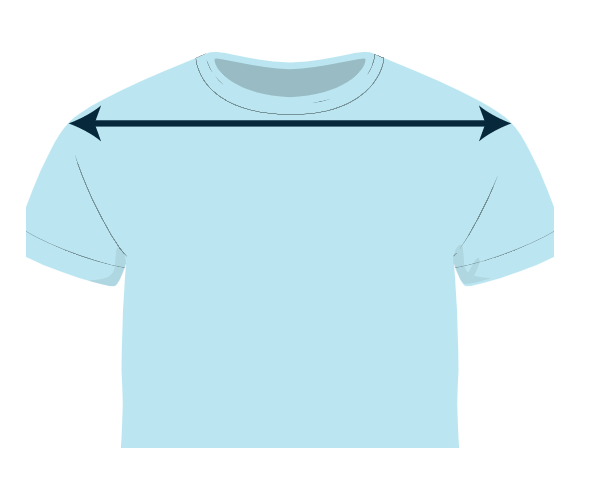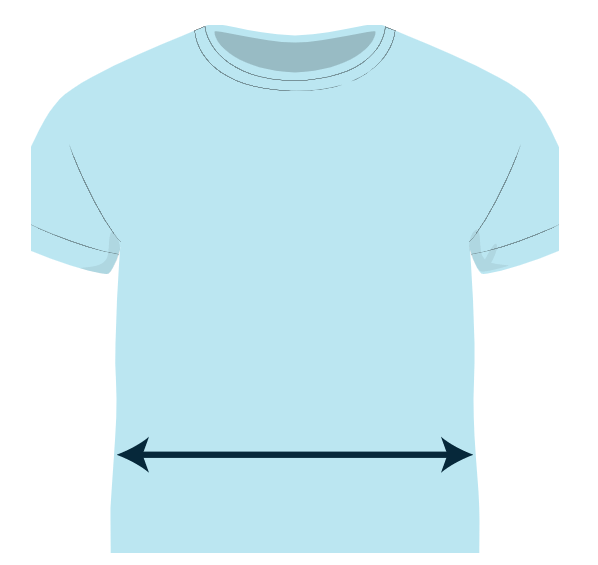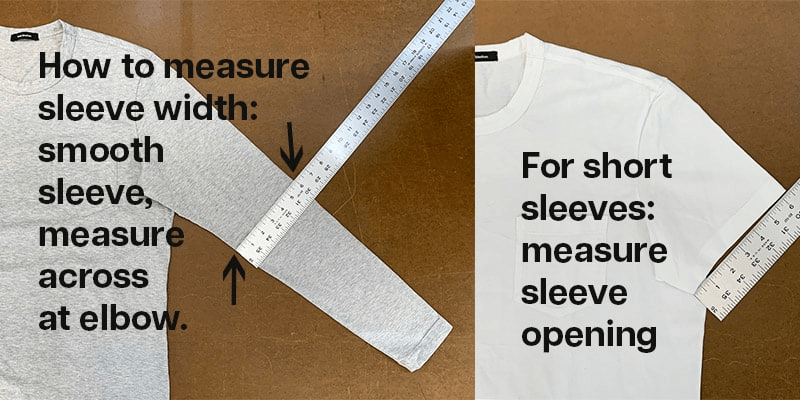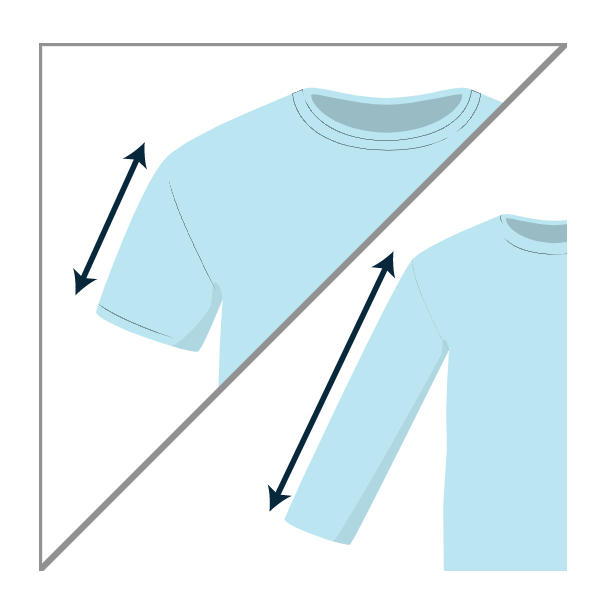At Lezhou Garment, we want to ensure you find the perfect fit for your body and style. We offer a T-Shirt Fit Profile, which uses six different fit points to find your ideal shirt. The following article will provide directions on how to find the right size, neck fit, stomach fit, sleeve fit, sleeve length and overall length for you. With a little bit of input from you, we will help you find a shirt that fits like a glove. Let us get started!
Size (Shoulders & Chest)
Your clothing size is based on the width of your shoulders and chest. There is a ½ inch difference in shoulder width and 1″ in chest width between sizes. We offer 11 sizes, including in-between sizes, so that you can find the perfect fit for you.
- Small: 15″ – 16″ / 38.1 – 40.6 cm
- Small/Medium: 16″ – 17″ / 40.6 – 43.2 cm
- Medium: 17″ – 18″ / 43.2 – 45.7 cm
- Medium/Large: 18″ – 19″ / 45.7 – 48.3 cm
- Large: 19″ – 20″ / 48.3 – 50.8 cm
- Large/XL: 20″ – 21″ / 50.8 – 53.3 cm
- XL: 21″ – 22″ / 53.3 – 55.9 cm
- XL/2XL: 22″ – 23″ / 55.9 – 58.4 cm
- 2XL: 23″ – 24″ / 58.4 – 60.9 cm
- 2XL/3XL: 24″ – 25″ / 60.9 – 63.5 cm
- 3XL: 25″ – 26″ / 63.5 – 66 cm
Shoulder Measurement

You can measure your T-shirt size by measuring a t-shirt you already own. Begin by pulling your best-fitting t-shirt through the shoulders. As indicated below, place your t-shirt face down on a rigid table (not a bed or other soft surface).
Measure from the shoulder point to the shoulder point. If the measurement is between sizes, round up to the next half-inch. For example, if your shoulder-to-shoulder measurement is 17.5″, round up to 18″ and try on an 18″ shirt. If the 18″ is too big or too small, adjust accordingly.
You may also want to consider whether you prefer a tighter or looser fit when deciding.
Please double-check your measurements to ensure they are comparable. Match your measurement to the table below to ensure it is correct.
- Labelled size = Shoulder Measurement
- S = 16 3/8
- S/M = 16 7/8
- M = 17 3/8
- M/L = 17 7/8
- L = 18 3/8
- L/XL = 18 7/8
- XL = 19 3/8
- XL/2XL = 19 7/8
- 2XL = 20 3/8
- 2XL/3XL = 20 7/8
- 3XL = 21 3/8
Rather than the current measurements, how would you adjust the shoulder fit to make it more comfortable?
Chest Measurement

Getting the chest measurement right when making a new t-shirt design is important. The chest is measured 1″ below the armholes, across the t-shirt. This is best done with a tape measure, but if you do not have one handy, you can use a string or a piece of ribbon.
Wrap it around the chest of the t-shirt, making sure to stay 1″ below the armholes, and then mark the spot where the ends meet. Once you have your mark, you can measure the distance between the two marks with a ruler.
This will give you your chest measurement. When entering your measurements into a t-shirt design program or ordering custom t-shirts, use this chest measurement.
To achieve precise measurements, use a measuring tape and compare your results to the chart below.
- Labelled size = Chest Measurement
- S = 18 3/4
- S/M = 19 3/4
- M = 20 3/4
- M/L = 21 3/4
- L = 22 3/4
- L/XL = 23 3/4
- XL = 24 3/4
- XL/2XL = 25 3/4
- 2XL = 26 3/4
- 2XL/3XL = 27 3/4
- 3XL = 28 3/4
You may discover that your shoulder and chest measurements match up to variations on our list when you compare them to the tables above. If this is the case, pay greater attention to your shoulder measurement when choosing your size.
Neck Fit
T-shirt necklines come in various shapes and sizes, each with its advantages. For those who prefer a closer fit around the neck, high-neck t-shirts are an ideal option. The higher cut helps to keep the fabric in place, reducing the risk of it stretching out or becoming loose over time.
In addition, the higher neckline can provide additional coverage and support, making it a good choice for those with larger busts. However, high-neck t-shirts can be tight and unpleasant for some people, so try on a few different designs before choosing one.
You will know you have found the best neckline when it is a comfortable yet practical balance. The following neck fit options are available to help you out.
- Standard (Most Popular)
- High-Neck
Anyone who has tried on a shirt knows that one of the most critical variables in assessing whether or not the shirt is comfortable to wear is the fit around the neck. A shirt that is too tight around the neck can be constricting and uncomfortable, while a shirt that is too loose can feel sloppy and unattractive.
You can offer two different styles of shirts for its customers, Standard Neck and High-Neck. High-Neck shirts are 1/4″ higher around the neck opening than Standard Neck, making them ideal for customers who prefer a tighter fit.
However, because High-Neck is a custom option, it is only available to existing customers who already know their fit.
As a result, customers who are unsure about their fitness should try on a Standard Neck shirt before ordering a High-Neck.
Stomach Fit
When it comes to t-shirt design, stomach fit is important. With four stomach fit options, you can control how much fabric you have around your stomach. The options are separated by one inch across the t-shirt at the stomach.
If you want a tighter fit, choose a size closer to your chest measurement. If you want a looser fit, choose a size closer to your actual waist measurement.
Remember that the closer you get to your measurements, the more fitted the t-shirt will be. Finally, you must determine how tight or loose you want the t-shirt to be. Just remember that the right stomach fit can make all the difference in the world regarding comfort and style.
- Stomach Fit (Ranking of popularity)
- Extra Slim (2%)
- Slim (36%)
- Standard (48%)
- Classic (3%)
Stomach Measurement

The first method is to lay your t-shirt face up on a hard surface like a table. Check the fabric for creases or folds, especially on the back of the shirt. Once it is smooth, measure across the shirt from one side seam to the other, halfway between the armhole and bottom hem. This measurement will tell you how big your stomach is. You can use this number to find a t-shirt with a similar width measurement.
Another way to measure your stomach for t-shirt fit is to simply put on a t-shirt that you know fits you well through the stomach. This time, measure from one side seam across your stomach to the other side seam. Again, ensure the tape measure is level and that you measure halfway between the armhole and bottom hem. This number will tell you how wide your stomach is so that you can find a t-shirt with a similar measurement.
- Labelled size = Standard (not Slim) Stomach Measurement
- S = 18
- S/M = 19
- M = 20
- M/L = 21
- L = 22
- L/XL = 23
- XL = 24
- XL/2XL = 25
- 2XL = 26
- 2XL/3XL = 27
- 3XL = 28
Sleeve Fit
The Roominess of the Sleeve is Fitted to Your Elbow to Shoulder. Your sleeve should be as roomy as possible from the bicep to the forearm. We have two options for Two Sleeve Fit that work for all our customers.
- Sleeve Fit (Ranking of popularity)
- Slim (54%)
- Standard (46%)
The Standard Sleeve Fit is for those with larger-than-average biceps. At the same time, the Slim Sleeve Fit is a more popular option among those whose biceps are average or leaner.
Sleeve Fit Measurement

Measuring the sleeve fit for a t-shirt design is important to ensure a comfortable and flattering garment. To get the perfect sleeve fit, you’ll want to look at a few key areas: the chest, underarm, and bicep.
- To measure the chest, wrap the measuring tape around the fullest part of the chest and across the shoulder blades.
- For the underarm measurement, wrap the tape around the narrowest part of the chest, just under the arms.
- Finally, to measure the bicep, wrap the tape around the widest part of the upper arm. These three measurements make it possible to determine sleeve size and ensure a comfortable and well-fitting t-shirt.
- Additionally, it is important to remember that t-shirt sleeves should be fitted but not too tight. They will be uncomfortable to wear if they are overly tight and may hinder movement. If they are too loose, they will look sloppy and may cause the shirt to bunch up.
Therefore, it is important to find a happy medium when selecting a sleeve size for a t-shirt design. With careful consideration, creating a shirt that looks and feels great is possible.
Sleeve Length
We offer 1″ increments in sleeve length for T-Shirts with LONG SLEEVE. We provide two short sleeve lengths for SHORT SLEEVE: 7.5 and 9 inches.
To calculate your Long Sleeve sleeve length, you will need to measure two things:
- your sleeve length and
- half of your shoulder width.
Sleeve Length Measurement

You can easily measure your sleeve length by holding a tape at the centre of your back and measuring from your shoulder to your wrist.
To measure half of your shoulder width, wrap the tape measure around the widest part of your shoulders and halve the measurement.
Once you have both measurements, add them together to get your Long Sleeve sleeve length. Remember that the width of your shoulders will also affect your sleeve length, so consider that when calculating the final measurement.
Overall Length
You will need a different overall length depending on your height and how big your belly is. We have 5 Overall Length options for you to choose from.
- Length (Ranking of popularity)
- 2″ Shorter (4%)
- 1″ Shorter (12%)
- Standard (65%)
- 1″ Longer (10%)
- 2″ Longer (9%)
Overall Length Measurement
T-shirt Length is an important factor to consider when choosing the right fit. Most people do not know how to measure Overall Length, the distance from the highest point of the shoulder down to the t-shirt’s bottom hem.
The best way to find your T-shirt Length is to measure a t-shirt you already own that fits you well.
First, choose your t-shirt with the best-fitting length.
Then, measure from the highest point of the shoulder down to the bottom of the hem.
Compare your measurement to the list below to find your T-shirt Length. We recommend ordering the larger size for a better fit if you are between sizes.
- Labelled Size = Standard Length
- S = 26
- S/M = 26 1/2
- M = 27
- M/L = 27 1/2
- L = 28
- L/XL = 28 1/2
- XL = 29
- XL/2XL = 29 1/2
- 2XL = 30
- 2XL/3XL = 30 1/2
- 3XL = 31
We offer Standard, 2″ Shorter, 1″ Shorter, 1″ Longer, and 2″ Longer shirt lengths. See our above T-Shirt Size Chart above for specific measurements of each length option.
Wrapping up
With the guide above, you will have all the tools you need to create an impeccable T-shirt for your fashion line that fits perfectly. As a veteran manufacturer in custom T-shirt design with over 18 years of experience, Lezhou Garment always puts its customers’ satisfaction first and foremost. For any questions or recommendations concerning this guide, please contact us via email.
